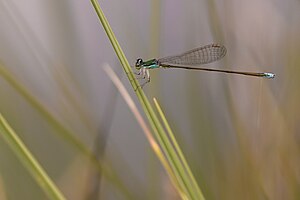Dwarf dragonfly
| Dwarf dragonfly | ||||||||||||
|---|---|---|---|---|---|---|---|---|---|---|---|---|

Dwarf Dragonfly ( Nehalennia speciosa ) |
||||||||||||
| Systematics | ||||||||||||
|
||||||||||||
| Scientific name | ||||||||||||
| Nehalennia speciosa | ||||||||||||
| ( Charpentier , 1840) |
The dwarf dragonfly ( Nehalennia speciosa ) is a member of the family of the slender dragonfly (Coenagrionidae). It is regarded as a Eurasian fauna element and is the smallest Central European dragonfly species with a body length of 20 to 25 millimeters.
It was named Dragonfly of the Year 2018 by the Society of German-speaking Odonatologists and the BUND in Germany .
features
The adults are graceful and have a wingspan of 25 millimeters. The males are colored light blue on the lateral thorax and metallic-green on the upper side. The end of the abdomen is colored blue from the middle of the 8th abdominal segment . The females appear in a green, blue or orange color morph and stand out because of their somewhat stronger abdomen. The wing marks are white, ocher or light brown. The wings are relatively short; when applied to the body, they only extend to the sixth abdominal segment. Overall, this dragonfly species can hardly be mistaken for its small size; there are certain similarities with the little pitch dragonfly ( Ischnura pumilio ).
Way of life
The flight season begins in mid-May and ends in September, with the abundance peaking in June and July. The species is a bad flyer. It mainly resides within stalks of sedge and is therefore easily overlooked.
Habitat and Distribution
The dwarf dragonfly needs shallow and not too acidic gullies in transition bogs and sedge swamps as a habitat . The characteristic vegetation of the habitat consists of mud sedge ( Carex limosa ), thread sedge ( Carex lasiocarpa ), pipe grass ( Molinia caerulea ), pond horsetail ( Equisetum fluviatile ), fever clover ( Menyanthes trifoliata ) and cotton grass ( Eriophorum spp.).
The distribution area extends from Central Europe to Japan, whereby it is generally temperate zones and formerly glacial regions. In Poland, the Baltic States and Belarus there are more constant occurrences, as there are even more suitable habitats there. In Germany the species is represented in moor areas in the Bavarian Alpine foothills , selectively in Upper Swabia and with large gaps in the North German lowlands, especially in Mecklenburg-Western Pomerania. Individual records are also known from western Austria and Switzerland.
Hazard and protection
The dwarf dragonfly is endangered because of its stenotopic behavior and high habitat loss; in Germany, for example, it is considered “critically endangered” ( Red List Category 1, as of 1998). Like all dragonfly species, the Federal Species Protection Ordinance gives it "special protection".
swell
Individual evidence
- ↑ The dwarf dragonfly is "Dragonfly of the Year 2018". bund.net, accessed December 22, 2017 .
- ↑ Federal Agency for Nature Conservation (Ed.): Red List of Endangered Animals in Germany . Landwirtschaftsverlag, Münster 1998, ISBN 3-89624-110-9 .
literature
- Klaas-Douwe B. Dijkstra: Field Guide to the Dragonflies of Europe . BWP, Gillingham 2006, ISBN 0-9531399-4-8
- Heiko Bellmann: The Kosmos dragonfly guide . Franckh-Kosmos Verlags GmbH & Co., Stuttgart 2007, ISBN 978-3-440-10616-7
- Bertrand Schmidt & Klaus Sternberg: Nehalennia speciosa (Charpentier, 1840) - dwarf dragonfly. P. 358–368 in: Sternberg / Buchwald (ed.): Die Libellen Baden-Württemberg. Volume 1: General part, dragonflies (Zygoptera) . Ulmer, Stuttgart 1999, ISBN 3-8001-3508-6
Web links
- LibellenWissen.de, photos of males and females of the dwarf dragonfly and interesting facts
- Nehalennia speciosa in the Red List of Threatened Species of the IUCN 2006. Posted by: Bernard, R. & Wildermuth, H., 2006. Accessed September 2, 2013.
